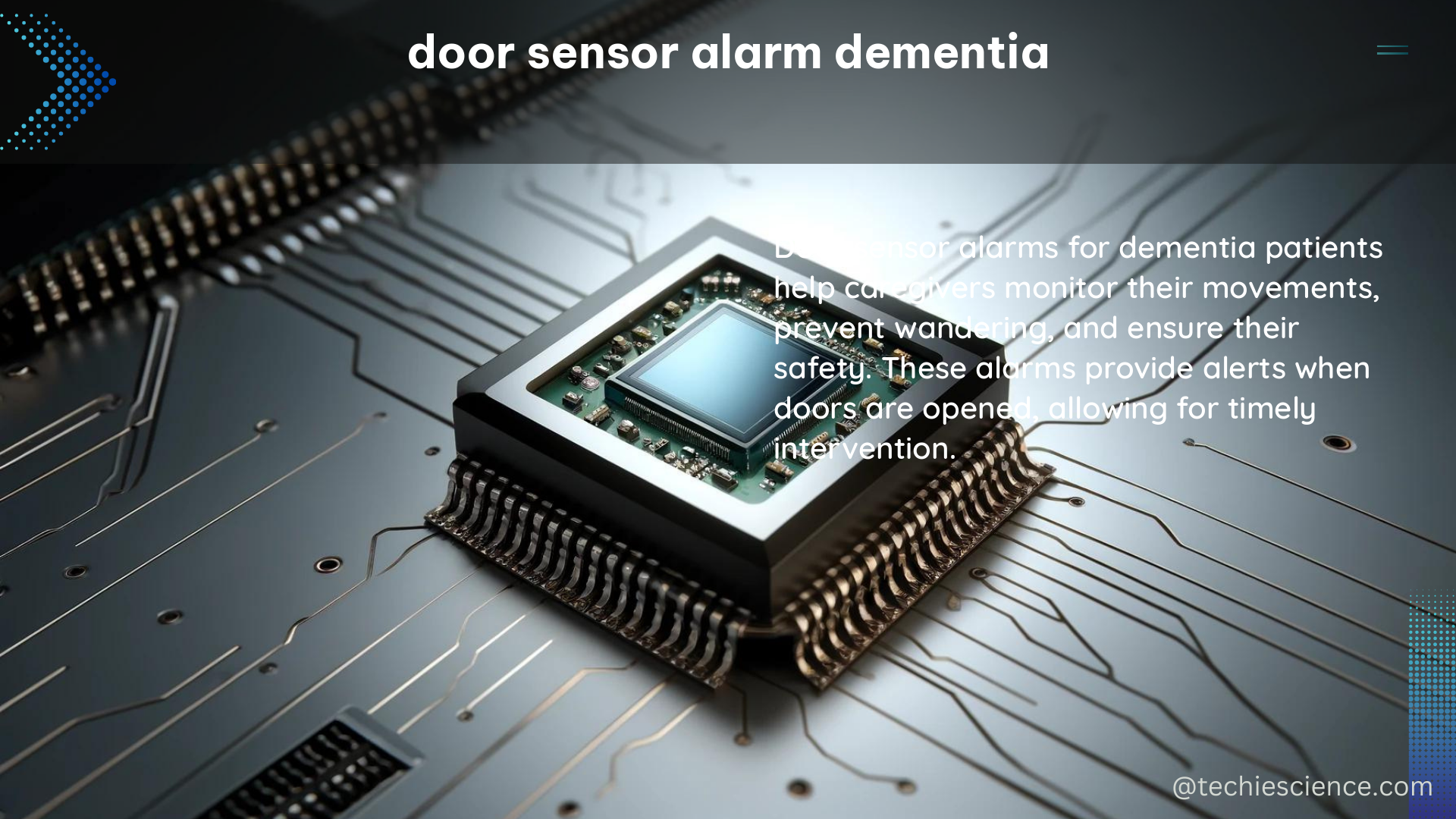The door sensor alarm for dementia is a crucial tool in preventing falls and injuries among elderly people with dementia. These sensors can monitor an individual’s movements, diagnose potential hazards, and alert caregivers in the event of a fall or prolonged inactivity. By gathering and transmitting information to remote sites, these systems can play a critical role in promoting the safety and well-being of elderly people with dementia.
Technical Specifications of Door Sensor Alarm for Dementia
The door sensor alarm for dementia typically includes the following technical specifications:
-
Pressure-Sensitive Mat or Sensor: These are placed at the entrance of the room or under the mattress. When the person gets up from bed or leaves the room, the sensor triggers an alarm that alerts the caregiver or family member.
-
Motion Sensors: Some systems also include motion sensors to detect any unusual movements or activities within the monitored area.
-
Cameras: Integrated cameras can provide visual monitoring and record any incidents or events for further analysis.
-
Microphones: Microphones can capture audio cues and alert caregivers to potential distress or emergency situations.
-
GPS Software: Many door sensor alarm systems for dementia also include GPS software that can pinpoint the senior’s location in the event of a fall or wandering incident.
-
Wireless Connectivity: These systems often utilize wireless communication protocols, such as Wi-Fi or Bluetooth, to transmit data to a central monitoring station or mobile devices.
-
Battery Life: The door sensor alarm should have a long-lasting battery life to ensure continuous monitoring, typically ranging from 6 months to 2 years, depending on the specific model and usage patterns.
-
Durability: The sensors and components should be designed to withstand daily wear and tear, as well as environmental factors, such as temperature and humidity, to ensure reliable performance.
-
Customizable Settings: The door sensor alarm should offer customizable settings, allowing caregivers to adjust sensitivity, alarm thresholds, and notification preferences based on the individual’s needs and preferences.
-
Integration with Smart Home Systems: Some door sensor alarm systems for dementia can integrate with smart home technologies, such as voice assistants or home automation platforms, to provide a more comprehensive and seamless monitoring solution.
Examples of Door Sensor Alarm Systems for Dementia

-
SENSOBOT Platform: This system combines sensors with a robotic platform to provide home monitoring of seniors. The sensors can detect falls and other emergencies, while the robotic platform can promptly respond to these events.
-
Non-Wearable Home Monitoring System: This system includes cameras, motion sensors, microphones, and floor sensors that can be embedded in the home to alert caregivers about potential hazards or emergencies.
-
Wearable Sensor Devices: These devices, such as smartwatches or pendants, can monitor an individual’s movements and vital signs, and trigger alerts in the event of a fall or prolonged inactivity.
-
Smart Flooring Systems: Some door sensor alarm solutions incorporate pressure-sensitive flooring that can detect when a person has left their bed or a specific area, triggering an alarm.
-
Integrated Smart Home Solutions: Advanced door sensor alarm systems for dementia can be integrated with smart home technologies, such as voice assistants or home automation platforms, to provide a comprehensive monitoring and response system.
Quantifiable Data on the Importance of Door Sensor Alarm for Dementia
According to a study by Thilo et al. (2016), seniors who remain on the ground for more than an hour after a fall, known as a “long-lie” event, often suffer more serious injuries, a higher rate of mortality, and a greater likelihood of being admitted to long-term nursing facilities. In fact, 50% of seniors who experience a “long-lie” event die within six months of the incident.
The door sensor alarm for dementia can play a critical role in preventing these “long-lie” events and reducing the risk of injury and mortality among elderly people with dementia. By promptly alerting caregivers to any falls or prolonged inactivity, these systems can ensure that seniors receive timely medical attention and reduce the likelihood of serious complications.
Conclusion
The door sensor alarm for dementia is a valuable tool in promoting the safety and well-being of elderly people with dementia. With its advanced technical specifications, including pressure-sensitive mats, motion sensors, cameras, and microphones, these systems can effectively monitor and diagnose potential hazards, and alert caregivers in the event of an emergency.
Quantifiable data highlights the importance of these systems in preventing “long-lie” events, which can lead to more serious injuries and higher mortality rates among seniors with dementia. By integrating these door sensor alarm systems into a comprehensive smart home or healthcare monitoring solution, caregivers can ensure that their loved ones with dementia receive the best possible care and support.
References:
– Patel, S., Park, H., Bonato, P., Chan, L., & Rodgers, M. (2012). A review of wearable sensors and systems with application in rehabilitation. Journal of neuroengineering and rehabilitation, 9(1), 1-17.
– Thilo, F. J., Hürlimann, B., Hahn, S., Bilger, S., Schols, J. M., & Halfens, R. J. (2016). Involvement of older people in the development of fall detection systems: a scoping review. BMC geriatrics, 16(1), 1-12.
– Overcoming Obstacles to Prevent Falls. (n.d.). Retrieved from https://www.hud.gov/sites/documents/OVERCOMINGOBSTACLESFALLS.PDF
– Caglayan, Y. (2021). Sensor-based fall detection and prevention for older adults with dementia. Victoria University. Retrieved from https://vuir.vu.edu.au/44700/1/YASAN_Caglayan-Thesis.pdf
– Baltinglass Community Hospital Inspection Report. (2023). Health Information and Quality Authority. Retrieved from https://www.hiqa.ie/system/files?file=inspectionreports%2F485-baltinglass-community-hospital-19-july-2023.pdf

The lambdageeks.com Core SME Team is a group of experienced subject matter experts from diverse scientific and technical fields including Physics, Chemistry, Technology,Electronics & Electrical Engineering, Automotive, Mechanical Engineering. Our team collaborates to create high-quality, well-researched articles on a wide range of science and technology topics for the lambdageeks.com website.
All Our Senior SME are having more than 7 Years of experience in the respective fields . They are either Working Industry Professionals or assocaited With different Universities. Refer Our Authors Page to get to know About our Core SMEs.